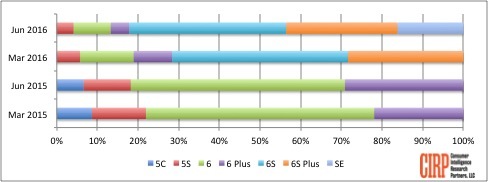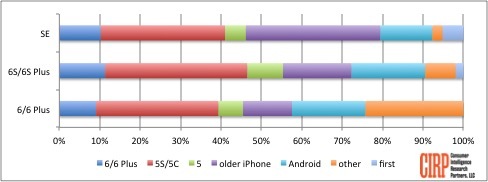Owners of Older Models Upgrade to SE, Not 6/6S Series
Consumer Intelligence Research Partners (CIRP), today released analysis of the results from its research on Apple, Inc. (NASDAQ:AAPL) for the fiscal quarter that ended June 25, 2015.
The June 2016 fiscal quarter represents the first quarter for the new iPhone SE, and the third full quarter after the launch of the iPhone 6s and 6s Plus models.
CIRP finds that the new iPhone SE accounted for 16% of total US iPhone sales, with iPhone 6S at 39% and iPhone 6S Plus at 26% (Chart 1).
Chart 1: iPhone Models US Sales Mix, Fiscal Quarters

In this quarter, the iPhone 6S and 6S Plus accounted for 65% of total sales. In contrast, a year ago, in the June 2015 quarter, their predecessors, the iPhone 6 and 6 Plus had 82% of total sales. A year ago, the iPhone 6 and 6 Plus grew their share of total iPhone sales relative to the previous quarter, up from 78% in the March 2015 quarter. In this quarter, the iPhone 6S and 6S Plus saw their share shrink relative to the March 2016 quarter, from 71% to 65%. It appears the iPhone SE is a viable iPhone entry in the US market.
Among iPhone SE buyers, 33% upgraded from an older iPhone, including iPhone 4S and prior. In comparison, 17% of iPhone 6S and 6S Plus buyers upgraded from an older iPhone, and 12% of iPhone 6 and 6 Plus buyers (Chart 2).
Chart 2: Previous OS and Model of iPhone Buyers, June 2016 quarter

iPhone SE appears to have appealed to owners of much older iPhone, and less to switchers from Android and other operating systems. On the one hand, the SE may have persuaded these owners of older iPhones to upgrade to a new phone, and possibly remain with Apple iOS. On the other hand, with its much lower retail price, iPhone SE also may have diverted these customers from purchasing a more-expensive iPhone 6/6S series phone, which will likely lead to a lower ASP in the quarter.
CIRP bases its findings on its survey of 500 US Apple customers, surveyed from June 27-July 13, 2016, that purchased an iPhone, iPad, or Mac in the US in April-June 2016 period. For additional information, please contact CIRP.
Support HuffPost
Our 2024 Coverage Needs You
Your Loyalty Means The World To Us
At HuffPost, we believe that everyone needs high-quality journalism, but we understand that not everyone can afford to pay for expensive news subscriptions. That is why we are committed to providing deeply reported, carefully fact-checked news that is freely accessible to everyone.
Whether you come to HuffPost for updates on the 2024 presidential race, hard-hitting investigations into critical issues facing our country today, or trending stories that make you laugh, we appreciate you. The truth is, news costs money to produce, and we are proud that we have never put our stories behind an expensive paywall.
Would you join us to help keep our stories free for all? Your contribution of as little as $2 will go a long way.
Can't afford to donate? Support HuffPost by creating a free account and log in while you read.
As Americans head to the polls in 2024, the very future of our country is at stake. At HuffPost, we believe that a free press is critical to creating well-informed voters. That's why our journalism is free for everyone, even though other newsrooms retreat behind expensive paywalls.
Our journalists will continue to cover the twists and turns during this historic presidential election. With your help, we'll bring you hard-hitting investigations, well-researched analysis and timely takes you can't find elsewhere. Reporting in this current political climate is a responsibility we do not take lightly, and we thank you for your support.
Contribute as little as $2 to keep our news free for all.
Can't afford to donate? Support HuffPost by creating a free account and log in while you read.
Dear HuffPost Reader
Thank you for your past contribution to HuffPost. We are sincerely grateful for readers like you who help us ensure that we can keep our journalism free for everyone.
The stakes are high this year, and our 2024 coverage could use continued support. Would you consider becoming a regular HuffPost contributor?
Dear HuffPost Reader
Thank you for your past contribution to HuffPost. We are sincerely grateful for readers like you who help us ensure that we can keep our journalism free for everyone.
The stakes are high this year, and our 2024 coverage could use continued support. If circumstances have changed since you last contributed, we hope you’ll consider contributing to HuffPost once more.
Already contributed? Log in to hide these messages.

